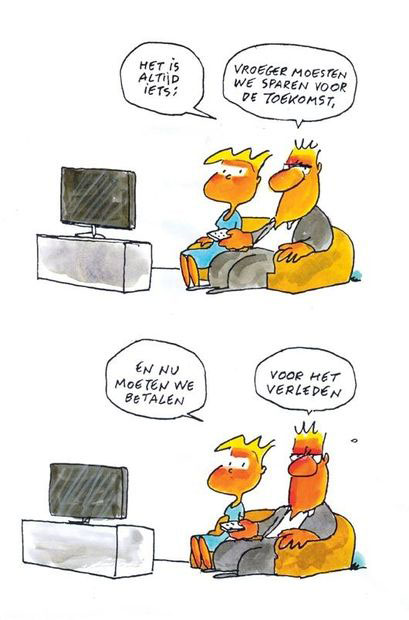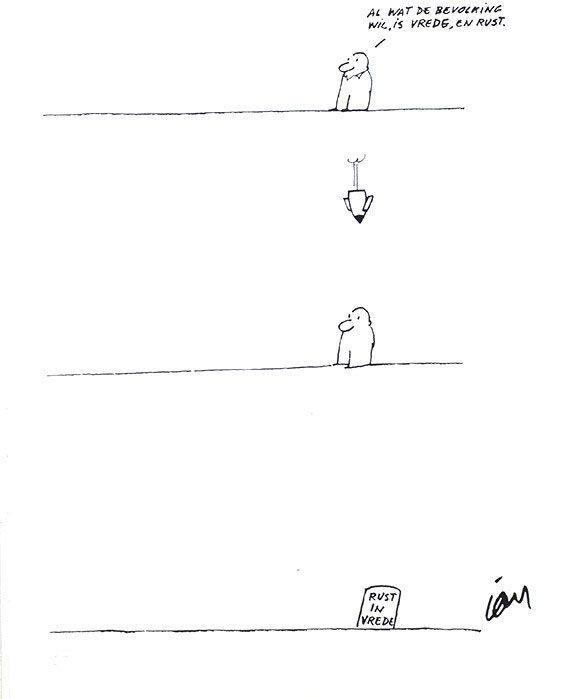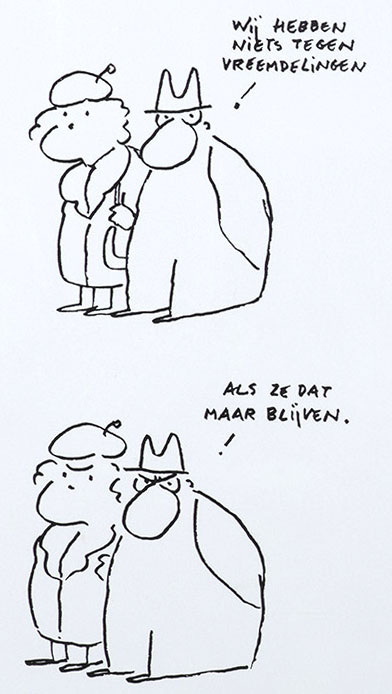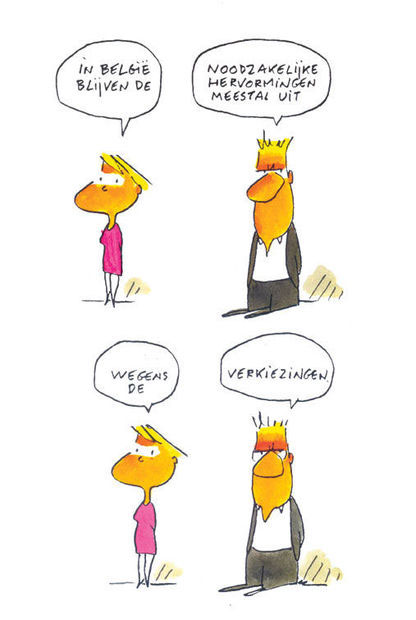Translation: "It's always something ... in the past we had to save for the future... and now we have to pay ... for the past."
Ian (earlier in his career: Jan) is a Belgian editorial cartoonist. He was a house cartoonist of Knack magazine from the 1970s until 2012, specializing in Belgian politics. Ian's political cartoons were notable for their use of sequential narratives and the recurring appearances of a nameless couple, making them comparable to comic strips.
Early life and career
Jan De Graeve was born in 1941 in Avelgem, not far from Ghent, as part of a family with eight children. His father owned a small farm animal food (fodder) company in Avelgem. During the 1930s, father De Graeve was fascinated with the Flemish fascist movement Verdinaso. He wasn't a religious man, but De Graeve's mother was a devout Catholic. She was in fact so fanatic, that when in adulthood Ian told her he was an atheist, she refused to speak to him any longer. A Jesuit monk had to be called for mediation. Although Ian considers himself a Flemish nationalist, he is nevertheless neutral about ideologies and political parties. De Graeve studied German Philology and then Press- and Communication Science at the University of Ghent. In terms of drawing, he was completely self-taught. In his spare time, he enjoyed making portraits of his college friends. His first job was writing brochures and organizing congresses for the textile industry. De Graeve also wrote for a liberal farmer's magazine and served as editor of Doorbraak, the party magazine of the Vlaamse Volksbeweging, a Flemish-nationalist think tank. This magazine also published his first cartoons.
Translation: "All the people want is peace and quiet." - "Rest in peace."
Early cartoons
De Graeve's introduction to professional cartooning came by accident. In the early 1960s, he was one of the editors of Het Beknopt Verslag, a service offering short reports of government plenary sessions. Originally, newspapers sent their own journalists to such meetings, often resulting in subjective reports. Het Beknopt Verslag recruited independent journalists to take notes during the sessions. After a short exam, De Graeve became part of the first group. During the long meetings, he often made sketches. These were noticed by columnist Karel De Witte, who introduced him to his newspaper, De Gazet van Antwerpen.
After becoming a regular cartoonist for De Gazet van Antwerpen, Ian's cartoons spread out to other newspapers and magazines as well, including De Morgen and Het Laatste Nieuws. He later also published in De Financieel-Economische Tijd, Trends, Mep, Zeg, Neerlandia, Anderzijds, De Juristenkrant, Onze Tijd, Welzijn, Deze Week in Brussel, De Autotoerist, Neerlandia, De Rode Vaan, Tijdschrift voor Rechtdocumentatie, VCVO-Nieuwsbrief, Politiek Journaal, Le Vif/L'Express, Trends/Tendances, Dietsche Warande en Belfort, La Libre Belgique, Pan and Jan Bucquoy's Spetters. Of all magazines, he liked the satirical Pan the best. For the rest of his career, De Graeve combined his cartooning with his job at Het Beknopt Verslag. Originally, he signed his drawings with his first name, "Jan". Since this a very generic name in the Dutch language, he later spelled it as "Ian". He also designed posters for democratic political parties of several different ideologies. In 1985 he drew a political propaganda comic, 'De Blauwe Ridders', to promote the socialist party SP. Other Belgian cartoonists who once drew party propaganda comics have been Rik Clément, Luc Cromheecke, Shirow Di Rosso, Mark Janssen and Geert Kinnaert.
1981 cartoon depicting Flanders Fields, the graveyard for the fallen soldiers of World War I. Translation: "And by the way, it's time we bring some new blood around here."
De Kiosk
In 1981, Ian released a compilation of thematic cartoons under the title: 'De Kiosk. 100 Karikaturen uit het Jaar 2030'. The hundred cartoons imagined the then distant year of 2030, when Flanders has become a prince-bishopric. Ian imagined that one single magazine would remain - De Kiosk - read by only one person.
Knack
From the late 1970s until 2012, Ian was most recognizable to mainstream audiences through his weekly page in the opinion magazine Knack. Originally titled 'Vijf Voor Zes' ("Five to Six"), it was later retitled as 'De Week van Ian' ("Ian's Week"). All his cartoons specifically focused on Belgian politics. In October 2012, Jörgen Oosterwaal became Knack's new chief editor. At that point, Ian's full weekly page had already been reduced to half a page in the reader's section. He decided to take the opportunity to retire. Hearing from his plan, his publisher offered him a full page again, but Ian was determined and quit anyway.
2010 cartoon depicting Belgian Prime Minister Elio Di Rupo. Translation: "As Prime Minister I could receive grants ... from Europe, while as Prime Minister I have ... to donate grants to Europe."
Style
Ian was a minimalist cartoonist. When he worked in color, he painted in simple watercolors. He never used elaborate backgrounds or scenery. Most of the comedy is verbal. Characters usually stand in a white void and hold monologues or dialogues with dry observations of a certain problem, dilemma, crisis or situation. Most are one-liners with a hidden pun or switcheroos. Ian often used narrative sequences, varying from two to six panels. Usually, his characters start a sentence in the first panel, which is carried on in the next, until the final panel delivers the punchline. This composition makes him closer to a comic artist than most editorial cartoonists, who usually limit themselves to one single drawing.
Another comic strip element in Ian's work was his use of two recurring self-created characters, namely a big-nosed man and a big-cheeked woman. They never received names, but represent the average man and woman. All his other characters are caricatures of real-life politicians, or national personifications like the Flemish Lion and the Walloon Rooster, who represent their respective language communities in Belgium. Most of the time, the anonymous man and woman complete each other's sentences, with the man delivering the punchline. The woman is always calm and unfazed, but her husband is visually frustrated and disillusioned about certain depressing, Kafkaesque or Catch-22 situations.
Translation: "We have nothing against strangers [immigrants]. As long as they stay strangers."
Ian never expressed a strong personal opinion. His neutral viewpoints helped him get published in both left- and right-wing papers and magazines, but also led to accusations of being a hollow opportunist. In his book 'De Overspannen Jaren' (Epo, 1996), the cartoonist Gal (Gerard Alsteens) defended his colleague: "Quite some experts condemn De Graeve as a weather vane who turns with the ideological color of his client. I strongly disagree, in my opinion my graphic companion in Knack remains himself, despite the paper roof above his head. He has a completely personal approach of the happenings in society. Jan is a nationalist who draws with Flanders in the back of his head, but at the same time he is the cool-headed analyst of an almost Asian inscrutability. De Graeve takes advantage of the privilege that, as a parliamentarian, he is able to witness the political arena as an eyewitness. The way he unravels the system is so secure that one has to be kind of initiated to appreciate cartoonist Jan for what he is really worth. Maybe he operates too inside, but he has my full support."
Ian's cartoons were collected in the book 'Ik Hou Van Dit Land, Zijn Leiders en Zijn Bevolking', 100 Perstekeningen 1981-1982' (Masereelfonds, 1982). In 1990 Knack released the book 'Knack's Cartoon Cabinet: De Hervormers. Politieke Cartoons van Ian & Gal Op Tekst Van De Knack Redactie' (Roularta, 1990), in which political drawings by their cartoonists Ian and Gal (Gerard Alsteens) were presented, with commentary from Knack's journalists and columnists.
Translation: "In Belgium ... necessary reforms are usually held off... because of... the elections."
Other activities
Ian illustrated the novel 'De Wonderlijke Avonturen van Cies Slameur, Gentsch Koetsier en Soldaat' ('t Zal Wel Gaan, Gent, 1997) by Paul Kenis and Pierre Schoentjes. His cartoons have also appeared in Roel Daenen's 'Het Is Maar Om Te Lachen. Hoe Cartoonisten De Wereld Veranderen' (Polis, 2016), a book featuring interviews with Belgian cartoonists regarding controversy and censorship in the light of the 2015 terrorist attacks on the subversive French magazine Charlie-Hebdo. Ian also made an animated sequence for Robbe De Hert's film 'Zware Jongens' (1984), starring the comedy duo Gaston en Leo. In 1989, he and Geert Van Den Broele made animated intermezzos for the sketch show 'Oei!' for BRT television (nowadays VRT). Several of the show's sketches were based on Brasser cartoons. Additionally, Ian is a permanent jury member of the Eurokartoenale cartoonists' contests in Kruishoutem.
Family connections
Ian's son, Sam De Graeve, is a well known columnist, cartoonist and journalist. Between 2010 and 2011, he was chief editor of Humo magazine and from 2011 until 2017, creative director of the TV production company Woestijnvis. Ian's nephew, Bert De Graeve, gained fame as managing director of the Flemish public TV channel VRT (1996-2002). Ian is also related to comic artist Ward De Graeve.
2010 cartoon depicting King Albert II of Belgium and Vice Prime Minister Johan Vande Lanotte. Translation: "The Flemings want to talk about money. The French speakers only about accents." (A pun on "centen" [coins] and "accenten" [accents].)









